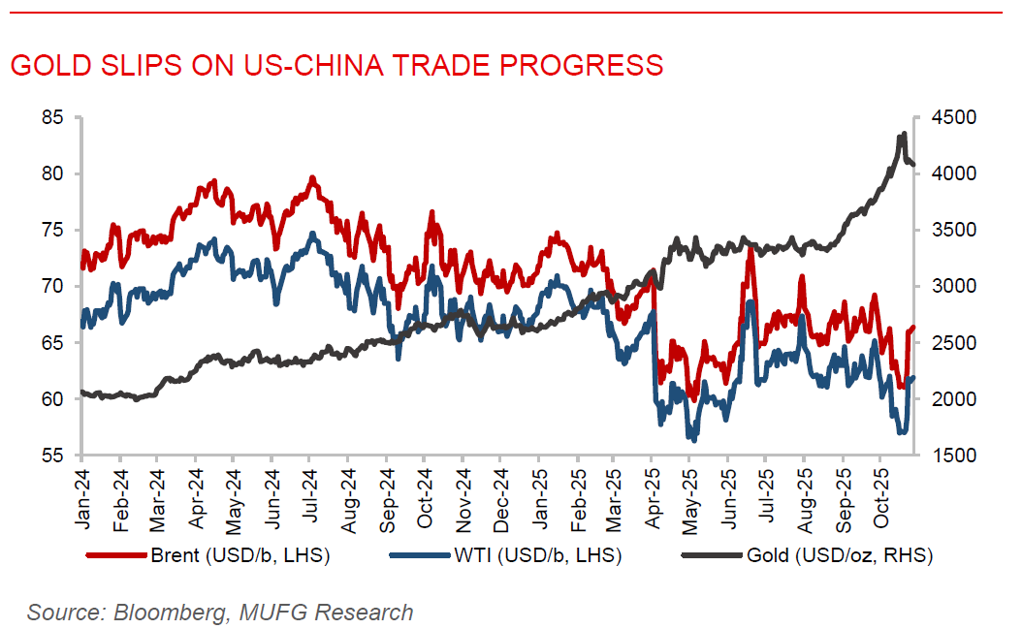To read the full report, please download the PDF above.
Middle East Daily
SOOJIN KIM
Research Analyst
DIFC Branch – Dubai
T: +44(4)387 5031
E: soojin.kim@ae.mufg.jp
MUFG Bank, Ltd. and MUFG Securities plc
A member of MUFG, a global financial group
Middle East Daily
COMMODITIES / ENERGY
Oil holds steady as US-China trade progress balances oversupply fears. Oil prices were broadly unchanged, with Brent trading just under USD66/b and WTI near USD62/b, as optimism from renewed progress in US-China trade negotiations was tempered by lingering concerns of a glut. Senior negotiators signalled agreement on key issues ahead of a meeting between President Trump and Xi, with US officials suggesting that threats of 100% tariffs on Chinese goods are now unlikely, a positive sign for global demand prospects. However, ongoing supply increases from OPEC+ producers continue to weigh on sentiment, even after US sanctions on Russia’s major oil firms briefly lifted prices last week by curbing expectations of unfettered supply flows. While the sanctions aim to complicate Russia’s crude trade rather than trigger a supply shock, the market remains cautious as added barrels continue to build, leaving oil stuck between improving demand signals and oversupply risk.
Gold slips as US-China trade progress eases haven demand. Gold retreated at the start of the week, falling as much as 1.3% toward USD4,058/oz, after posting its first weekly decline since mid-August. The pullback comes as signs of an imminent US-China trade deal reduced geopolitical and economic uncertainty, weakening demand for the safe-haven metal. The price reversal follows a rapid rally that pushed gold above USD4,380/oz last Monday, leaving it technically overbought. Still, gold remains up around 55% this year, supported by central-bank purchases and investor hedging against large fiscal deficits through the “debasement trade”. Attention now turns to a heavy central bank calendar, with rate decisions from the Fed, European Central Bank and Bank of Japan, where further monetary easing could provide renewed support for non-interest -bearing assets like gold.
MIDDLE EAST - CREDIT TRADING
End of day comment – 24 October 2025. Very quiet day overall. On trax inter dealer transactions outstrip buy side transactions which says a lot about today’s activity. The morning felt a touch weaker, there was some overhang from ydays rates induced selling of bonds and UST were softer as well. Mainly dealers tried to cut out of risk ahead of the numbers. With CPI coming in lower than expected the market had a quick pop but with no follow through activity and UST coming off the highs flows subsided quickly. In price or spread terms the market overall didn't moved much. What has staying power though is the good bid in duration bonds, especially in quasi sovereign bonds which still trades at a decent spread to sovereigns. Take ADNOUH 47s getting again bought today and closing +0.25pt/-3pb. MUBAUH long end equally remained well bid closing +0.25pt/-2bp. Against this there are more bonds in the belly which need to get worked through, mainly in newer issues. Talking of new issues OMGRID 30s closed 99.70/99.85 establishing itself like other recent new issues just below reoffer.
MIDDLE EAST - MACRO / MARKETS
Turkey-GCC trade expansion initiatives. Turkey and key GCC economies, including Kuwait, Qatar, and Oman, agreed on October 24 to target a combined USD15bn in bilateral trade as part of an accelerated push toward stronger non-oil economic integration and investment partnerships, following high-level talks during President Erdogan’s visit. The initiatives builds on ongoing negotiations for a comprehensive free-trade agreement and it aligns Turkish private-sector strengths in construction and infrastructure with the Gulf’s major diversification programs, where Turkish firms already hold significant project pipelines. The trade goal underscores a strategic shift toward expanding industrial and services linkages, improving logistics and payment and reducing reliance on traditional trade corridors. If regulatory harmonisation, market-access measures and financing frameworks progress, this initiative could materially boost project finance flows, joint-venture formation, technology transfer and employment creation across both economies, while meaningfully supporting external-sector resilience given each side’s sensitivity to external shocks.
GCC growth continues to strengthen on non-oil momentum. According to the Statistical Centre for the Cooperation Council for the Arab Countries of the Gulf the GCC economy expanded in Q1 2025 with nominal GDP rising 5.7% y/y to about USD588.1bn, while real GDP reached roughly USD466.3bn, reflecting around 3% real growth. The data show that non-oil sectors remained the primary growth engine, accounting for about 73.2% of total economic output., whereas hydrocarbon contributed 22.9%, alongside meaningful roles for manufacturing (12.7%) and wholesale and retail trade (9.6%), with the remainder distributed across a diverse set of services and activities. Together, these figures point to continued economic expansion across the Gulf and underscore the region’s ongoing shift toward more diversified, non-oil led growth dynamics, going forward supported by ongoing structural reforms and investment in expanding private-sector activities.

